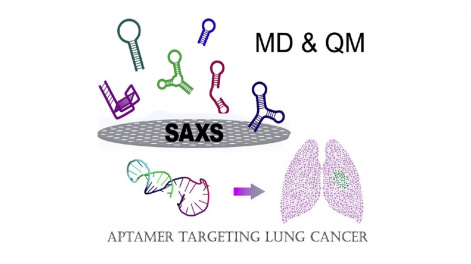Scientists "cut off the tail" of aptamers and made them more specific for cancer cells
13 September 2021 г.

Advances in biomedical nanotechnology have opened up the possibility of using in biology and medicine single-stranded DNA molecules designed in the laboratory, namely, aptamers. Aptamers function as synthetic analogs of antibodies and bind to target cells, allowing the recognition and detection of, for example, cancer cells. However, due to the length of these molecules, they can be difficult to synthesize, and the accuracy of their binding suffers due to the fact that not the whole molecule participates in the binding. It is rather difficult to determine which part of the aptamer should remain and which should be cut off to improve its properties.
Scientists of the Federal Research Center "KSC SB RAS" together with colleagues from the M.V. Lomonosov Moscow State University, Finland, Germany, Canada, Japan and the USA solved the difficult problem of optimizing the aptamer for the diagnosis of cancer cells. Unlike its predecessor, the new sequence consists of 35 nucleotides rather than 80. This length turned out to be optimum and made it possible to improve the binding properties of the molecule with cancer cells due to its greater specificity to the protein target.
The characteristics of an aptamer depend entirely on its structure. Therefore, the successful modification of such DNA structures into more efficient forms, including a decrease in its length, requires information on the spatial structure of the molecule. Before truncating the molecule, experts created its three-dimensional model. For programming and calculation, the resources of several world scientific laboratories were used, including the supercomputer center of the Russian Academy of Sciences. Knowing how the aptamer looks like and is located in space, scientists were able to change it without damaging the structure and without affecting the basic properties and characteristics necessary for its application and binding to cells.
To demonstrate that the truncated aptamer binds to cancer cells, the researchers tested its effect on stained lung tumor tissue obtained from people with the disease. Like antibodies, aptamers bind to special target cells and allow one to "see" cancerous tumors and the boundaries of their spread. The new modification of the aptamer binds with higher accuracy to lung tumor cells, but does not bind to healthy tissues. The reason for this is an increase in the binding energy of the molecule and a reduction in the options for the molecular recognition process due to a decrease in length.
“Aptamers are used as clinical reagents for targeted therapy and drug delivery, diagnostics and biosensors. We've learned how to make them more specific and shorter. We removed the unnecessary "tail" which increased the aptamer's ability to bind to other cells. In addition, a long molecule has a large degree of freedom: it can curl up in response to external conditions and will no longer fulfill its role. A small number of nucleotides gives less options for binding to something else and changing shape. In an experiment with lung cancer cells, short aptamers bound well and stained cancer tissues, and at the same time ceased to mark others around healthy cells or tissues of other types of cancer, for example, breast cancer. "Removing the tail" made the aptamer more specific, and also made it possible to significantly reduce the cost and facilitate its synthesis due to a smaller amount of nucleotides, "said the project supervisor Anna Kichkailo, Doctor of Biological Sciences, Leading Researcher, Head of the Laboratory of Digitally Controlled Drugs and Theranostics of the Federal Research Center KSC SB RAS, head of the laboratory of biomolecular and medical technologies, V.F. Voino-Yasenetsky Krasnoyarsk State Medical University.
The main part of the research was carried out within the framework of the project No. 21-73-20240 of the Russian Science Foundation; the work carried out by foreign and Moscow co-authors was supported by foreign grants and the Russian Foundation for Basic Research.
Share:
